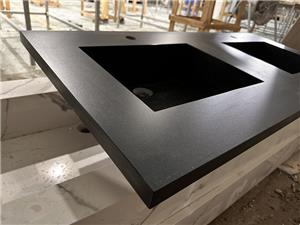How is the sintered stone produced?
The sintered stone production process

Sintered stone is a new type of porcelain slab, mainly made of natural mineral materials (such as quartz, marble, kaolinite, etc.), which are processed by special processes, such as crushing, screening, mixing, etc., and then pressed under high pressure, and finally fired at a high temperature of more than 1200°C.
Making a sintered stone slab usually involves the following steps:
1.Pretreatment of raw materials: The raw material is ground into a fine powder to ensure the uniformity and fineness of the particles.
2.Add resin and glass fiber: Resin and glass fiber are added to the raw material, and the resin accounts for about 20% of the total material, to enhance the adhesion, strength and fire resistance of the material.
3.Mix and press: The treated raw material is evenly mixed with the additive, and then pressed under high pressure to make the desired sheet shape, so that a strong structure is formed between the raw material particles.
4.Sintering and curing: Pressed big porcelain slab is fired at a high temperature of over 1200℃, causing chemical reaction of particles in the material to form a dense structure.
5.Post-processing: After sintering, the sintered stone slabs are cut, polished and other post-treatment processes to adapt to different needs and improve the surface texture.




